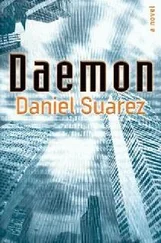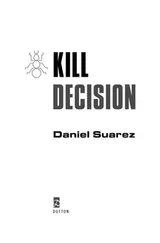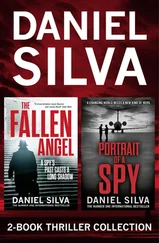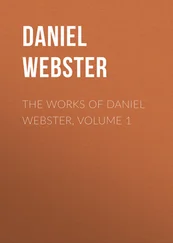She met his stare and nodded. “That’s extremely decent of you.”
“Just don’t ask me again after a couple of beers.”
She nodded acceptance, then turned to the younger agent standing nearby. “Dwight, can you locate the ERT lead? I want a definitive body count as soon as possible.”
“On it, Denise.” Dwight Wortman, the younger agent, nodded and took off toward the emergency vehicles.
Davis started marching toward the smoldering blast site. She turned to Falwell, who had fallen in alongside her. “What do we have so far?”
“Definitely our boy. Cotton posted on YouTube minutes after the bombing. Shows his victims struggling right up till the last moment.” He passed Davis a tablet computer.
She tapped at the screen, and the video began to play. A familiar face—Richard Louis Cotton surrounded by his masked followers. Cotton pointed at some complex mechanical assembly with researchers lashed to it. “…an outrage against creation! This—”
Davis paused it. “Does he say anything new?”
“No. Same old return-to-the-Iron-Age crap.”
She passed the tablet back to him. “What about the upload?”
“Cyber division says it was a stolen account. The file uploaded from an IP address in Kiev, Ukraine.”
“And the domain owner?”
“It’ll be a proxy, but they’re checking. The Ukrainian authorities are sometimes helpful. Sometimes not.”
“Were we able to get a camera serial number from the video?”
“No—old equipment again. The techs found pieces in the bomb crater.”
“Betacam?”
He nodded. “Yeah. Jerry-rigged with wireless for streaming to the Web, just like the others.”
“Bypassed technology—cul-de-sacs of innovation. That’s Cotton’s signature, all right.”
“What do we do about the YouTube video?”
“Does it show anything graphic?”
Falwell shook his head. “No. It whites out at the end.”
“Then get me a listing of IP addresses that accessed it before this attack hit the news. Cotton’s thorough, but his Winnower pals might not be as sharp. One of them might have checked from a stateside computer to see that their ‘masterpiece’ was uploaded successfully. They’ll make a mistake sooner or later, so we need to cover every angle.”
“For antitech zealots, these guys sure know their way around technology.”
“Hypocrisy is the least of their malfunctions.”
They had now arrived at the edge of the blast crater. Big blocks of masonry, twisted I beams, and thousands of singed documents, computer parts, pieces of furniture, and inscrutable machine parts were scattered across the pavement. Numbered evidence flags were stabbed into the ground here and there.
She sniffed the air and let out an involuntary whistle. “Another ammonium nitrate bomb. A big one this time.”
“Lab’s running the chemical taggants in the fertilizer, but I’m willing to bet it originates from that ’06 boxcar shipment used in the past two bombings.”
Davis kneeled down to examine a singed origami sphere skewered in place with an evidence tag. The geodesic facets were symmetrical. Perfect.
Falwell nodded toward it. “They’re finding those things all over the place.”
She stood and noticed the burned-out, crumpled wreckage of what was clearly an expensive sports car, partially buried beneath fallen masonry. New York vanity plates were visible: “ MKT WIZ .” Davis looked back at Falwell.
“Aston Martin One-77.”
“A little upscale for the neighborhood.”
“Belonged to one of the victims. How’s two-point-four million dollars grab ya?”
She shot a look back at him. “You’re joking. For a car?”
“Only seventy-seven were produced, thus the name. I guess they’ll have to start calling them Aston Martin One-76s now.”
“And the owner?”
“An Albert Marrano, executive vice president at Shearson-Bayers, a hedge fund in New York. He and a colleague were in the building; ID’d on the videotape along with other victims. The techs are still going through the human remains. Bones. Some organs. Fingers. Initial estimate is we’ve got pieces of six bodies—which matches the video they uploaded.”
Davis looked down at another numbered evidence marker stabbed into the ground next to fresh tire tracks running through old snow. The tire tracks ran near the wrecked Aston Martin. Pieces of debris had deformed them in places. “Fresh tracks—just before the blast from the looks of it.” She looked behind the Aston Martin and traced its route through snow patches as best she could. “Arrived after our investors.”
“ERT’s looking into it.”
“Pull video from intersection cameras for a mile in every direction. When the techs narrow down vehicle types from the tires, let’s go through the videos—see if we can’t eyeball our Winnowers without their masks as they arrive or depart.”
He made notes. “You got it.”
“So were the Wall Street guys just unlucky to be here? Or did they inadvertently tip Cotton off to something he didn’t like? Have Dwight run a check on every press release, investor newsletter, or media interview that hedge fund has done in the past year. See if they ever mentioned this firm.” She turned to look for an intact business sign. No luck. “What’s this company called, anyway?”
Falwell flipped through his notes. “Chirality Labs.”
“What sort of research did they do?”
“Something called ‘chiral superconductors.’”
“Superconductors I get, but what’s ‘chiral’ mean?”
“I looked it up—didn’t really understand the explanation, though. Something about electrons only moving in one direction.”
“Well, something they did here pissed Cotton off. Made him bring in his death squad.”
“If he’s so upset about advanced tech, why doesn’t he go after a major aerospace or biotech firm?”
She pondered that. “Too difficult. He only goes after easy marks.” She glanced around at the aged building. “I mean, look at this place. They didn’t even have a perimeter gate. Half a dozen employees. It’s like the other bombings. Small, relatively unknown firms. He wants victims for the news. Let me take a guess about this company: They weren’t at the forefront of anything. No distinguished principals.”
Falwell glanced down at his notes. “This Alcot guy taught physics in the Ivy League.”
“I saw that. Retired, though, wasn’t he? In his eighties. Just a figurehead maybe.” Davis thought for a few moments more in silence. “What about their funding?”
“I pulled their business filings this morning.” Falwell brought up PDF images of business permits, incorporation papers, and other documents on his computer tablet and started flipping through them. “Looks like initial funding came from this Shearson-Bayers, the New York firm, and judging by the chronology on these other SEC filings, I’d say the founders were canny enough to use the initial investment to get buy-in from other, smaller investors.”
“Any repeats from past bombings?”
Falwell shook his head. “We’ll check shell companies and subsidiaries, but on a first look, no. They’re Midwest and Southeast partnerships. Probably doctors and lawyers without Silicon Valley connections looking for a big tech score.” He flipped through a few more pages. “Looks like they might have been sold a bill of goods.”
She looked back at him. “Why do you say that?”
“The company president, this Jon Grady guy: thirty-one years old. His parents said he’d received a National Science Foundation grant.”
“And he didn’t.”
He shook his head. “NSF has no record of him.”
“And his academic background?”
“Heh. That’s the thing. He didn’t really have one. I mean, not a real school, anyway. Dropped out of Albany. Got a bachelor’s and a master’s in physics from an online diploma mill. His parents said they were real proud of him because he’d overcome a learning disability.”
Читать дальше












